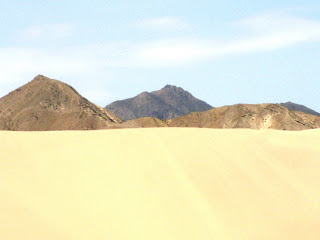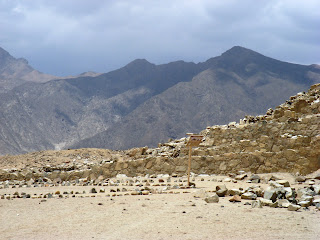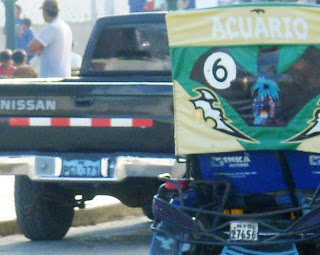 Caral is an archeological site located about 3 hours north of Lima. There is a long stretch on the PanAmerican Highway along the coast that is quite spectacular. It's not SO far as the bird flies (~200 km), but the last 45 minutes or so of the ride are on dirt roads. At one point you have to pass through private land, including large chicken farms. Our bus had to be disinfected (on the outside only) before we were allowed to drive through.
Caral is an archeological site located about 3 hours north of Lima. There is a long stretch on the PanAmerican Highway along the coast that is quite spectacular. It's not SO far as the bird flies (~200 km), but the last 45 minutes or so of the ride are on dirt roads. At one point you have to pass through private land, including large chicken farms. Our bus had to be disinfected (on the outside only) before we were allowed to drive through.The dirt road through the desert is very narrow and at times quite treacherous. Luckily, we had a very competent bus driver.
Caral is said to be one of the most ancient cities in the Americas. It was populated by the Chico culture from about 2600 to 2000 BC. The site contains numerous pyramids, each of which had a particular role. There is also a large amphitheater and the remnants of habitations. The local people grew cotton and other crops along the Supe River, which creates a narrow stretch of arable land along the Supe Valley. The rest is just desert, though quite beautiful in its own way.
Findings at the site include lots of small flutes made of animal bone; little trumpet like instruments; figurines of men, women, or children made of unbaked clay; fabrics, nets, and bags; and small pots made of molded, unbaked clay - far more primitive than the beautiful pottery you see from later cultures dating all the way up to the Incas.







After spending several hours visiting the Caral site and excavation, we went to a nearby village to see the small museum, which hosts the collection of materials found at Caral. This photo just gives you a small sense of the street activity and life of this (and many other) small, Peruvian village.

To end the day, we went to a nearby beach, close to which is another archeological site, which shows evidence of having been associated with Caral. It was inhabited by fishermen who traded fish and shellfish with the people at Caral, who supplied them with cotton and other crops. The photo gives you a sense of the Pacific Ocean, and features one of several beaches we have encountered where the locals claim that San Martin landed with his men to come liberate Peru from Spain.

No comments:
Post a Comment